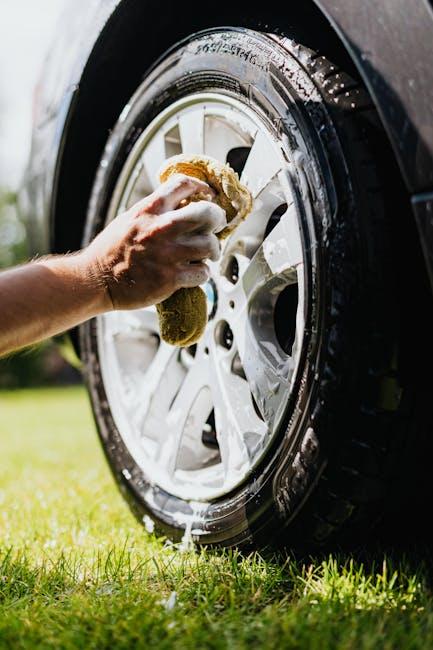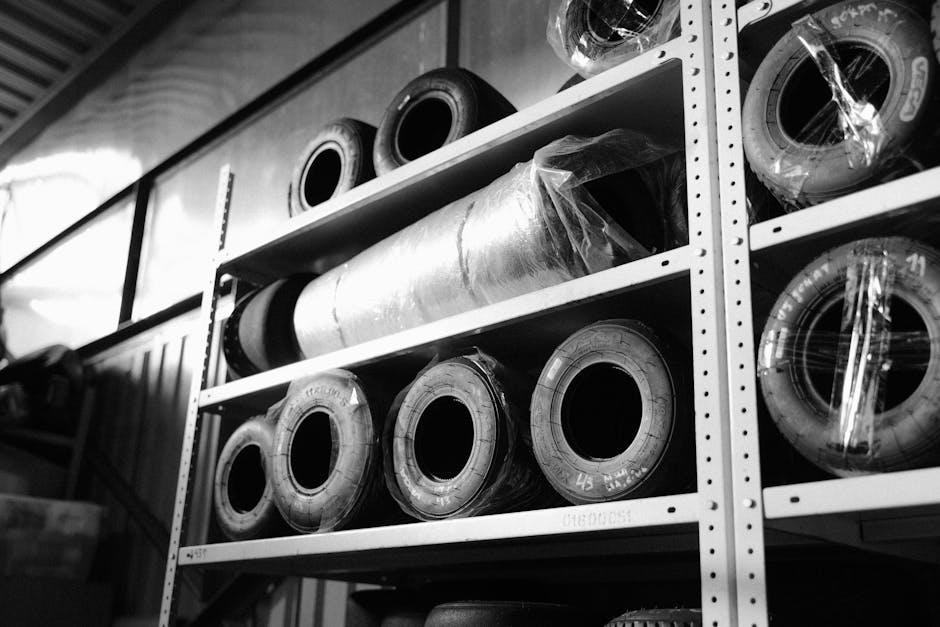As the seasons shift and your vehicle’s needs change, one essential task often slips under the radar: properly storing your tires during the off-season. Whether you’re swapping out winter snow tires for summer treads or packing away summer tires until next year, the way you store them can make all the difference in preserving their longevity and performance. In this guide, we’ll explore practical tips and best practices to keep your tires in top shape while they rest, ensuring they’re ready to roll when the season calls again.
Table of Contents
- Choosing the Ideal Location for Tire Storage
- Preparing Tires for Long-Term Off-Season Rest
- The Best Methods to Clean and Protect Your Tires
- Optimal Positioning Techniques to Prevent Warping
- Using Tire Bags and Covers for Extra Protection
- Monitoring and Maintenance Tips Throughout the Off-Season
- Q&A
- Insights and Conclusions

Choosing the Ideal Location for Tire Storage
Finding the perfect spot to stash your tires away during the off-season can make all the difference in preserving their lifespan. Ideally, you want a cool, dry, and dark environment. Avoid places exposed to direct sunlight or extreme temperatures, as UV rays and heat can cause the rubber to deteriorate and crack. Basements, climate-controlled garages, or dedicated storage rooms often fit the bill perfectly. Make sure the area is well-ventilated to prevent moisture buildup, which can lead to mold or spoilage of the tire material.
When selecting a location, keep these key factors in mind:
- Temperature Stability: Fluctuating temperatures weaken rubber compounds.
- Humidity Control: Excess moisture promotes corrosion on metal tire parts.
- Cleanliness: Dust and dirt can embed into treads and sidewalls.
- Off the Floor: Use shelves or pallets to keep tires elevated and away from cold, damp concrete.
| Ideal Storage Spot | Pros | Cons |
|---|---|---|
| Climate-Controlled Garage | Best temp and humidity control | Requires space and may cost to maintain |
| Basement | Cool and dark environment | Can be humid if not ventilated |
| Indoor Storage Room | Clean with limited temperature swings | May be less accessible for quick tire swaps |

Preparing Tires for Long-Term Off-Season Rest
Before tucking your tires away for the long haul, it’s crucial to give them a thorough cleaning. Removing dirt, brake dust, and road grime helps prevent corrosion and rubber degradation. Use a mild soap solution and a soft brush, avoiding harsh chemicals that can damage the rubber. Once clean, dry the tires completely to eliminate any moisture that could cause mold or mildew during storage. To further protect your tires, apply a tire protectant formulated for long-term storage; this helps maintain flexibility and prevents cracking.
Storing your tires properly will prolong their life and keep them in prime condition for the next season. Choose a cool, dry, and dark place, as exposure to heat, sunlight, and humidity accelerates deterioration. When possible, store tires vertically on racks to avoid deforming the sidewalls, and if stacking is necessary, limit it to no more than four tires high. Wrap each tire in an opaque, airtight plastic bag, squeezing out as much air as possible to reduce oxidation. Here’s a simple guide for optimal conditions:
| Condition | Recommended Setting |
|---|---|
| Temperature | Below 77°F (25°C) |
| Humidity | Below 50% |
| Lighting | Dark or low light |
| Storage Angle | Vertical preferred |

The Best Methods to Clean and Protect Your Tires
Maintaining your tires goes beyond just washing them; it’s about creating a protective barrier that preserves their quality during long storage periods. Begin by rinsing off dirt and brake dust with water, then apply a dedicated tire cleaner that penetrates and lifts stubborn grime. Use a soft brush to gently scrub the sidewalls without harming the rubber. After rinsing, dry the tires thoroughly using a microfiber cloth to avoid water spots. Never use harsh chemicals or petroleum-based products, as these can accelerate cracking and deterioration.
To shield tires from UV rays and ozone exposure—which accelerate aging—opt for specialized tire protectants enriched with UV inhibitors. These products nourish the rubber, keeping it supple and preventing premature aging. Here are some essential practices for tire care before storage:
- Clean thoroughly: Remove dirt and contaminants.
- Dry completely: Avoid moisture buildup.
- Apply protectant: Use products with UV blockers.
- Store properly: Keep in a cool, dry, dark place.

Optimal Positioning Techniques to Prevent Warping
Proper tire storage hinges on how you position them to maintain their shape and integrity throughout the off-season. When stacking tires, it’s essential to avoid piling them too high, which can cause deformities at the bottom tires due to excess weight. Instead, store tires vertically on racks or use tire hooks to mimic the shape of the wheel, preventing any flat spots or warping that can develop over time. For tires stored without rims, placing them upright rather than laying them flat helps preserve their roundness and makes for easier quality checks.
For extra protection, utilize a small table like the one below to determine the best method based on your tire type:
| Tire Type | Recommended Position | Key Benefits |
|---|---|---|
| Mounted on Rims | Hang or stand upright | Maintains shape; reduces pressure points |
| Unmounted Tires | Stand upright | Prevents warping and flat spots |
| Performance Tires | Individually wrapped & hung | Preserves tread quality |
- Rotate tires every few weeks if stored upright to distribute pressure evenly.
- Avoid exposure to extreme temperatures or direct sunlight during storage.
- Use protective covers to keep dust and moisture away.

Using Tire Bags and Covers for Extra Protection
Protecting your tires from environmental factors during storage is crucial to maintaining their longevity and performance. Using tire bags or covers acts as a shield against dust, dirt, UV rays, and moisture — all of which can cause premature tire degradation. Tire covers specifically designed for storage typically offer airtight sealing, preventing oxidation and keeping rubber supple. This extra layer of defense minimizes the risk of cracks and flat spots, so when it’s time to reinstall your tires, they’re in peak condition.
When choosing between various tire storage options, it helps to know the key benefits that each method provides. Here’s a quick comparison:
| Feature | Tire Bags | Tire Covers |
|---|---|---|
| Seals moisture & air | Yes | Partial |
| UV Resistance | Good | Excellent |
| Reusable | Yes | Yes |
| Ease of Use | Easy to seal | Simple fit-over |
Whether you opt for airtight tire bags or UV-blocking covers, the extra protection ensures that your tires remain safe from harsh conditions, extending their life through the off-season and ready for a smooth return to the road.

Monitoring and Maintenance Tips Throughout the Off-Season
Keeping your tires in prime condition during storage means regularly inspecting them for signs of wear, cracks, or pests that may have taken up residence. Rotate their position every few weeks to prevent flat spots from forming, especially if they are stacked. Maintaining a consistent, cool temperature free from direct sunlight and moisture is also crucial, as fluctuations can degrade the rubber compounds. Don’t forget to keep them away from chemicals or solvents, which can cause material breakdown.
To assist with your monitoring process, consider using this simple checklist:
| Task | Frequency | Notes |
|---|---|---|
| Visual inspection | Every 2-3 weeks | Check for cracks or deformities |
| Rotate tires | Monthly | Prevents flat spots |
| Ensure dry environment | Continuous | Humidity control recommended |
| Avoid chemical exposure | Always | Keep away from solvents and grease |
Q&A
Q&A: How to Store Tires During the Off-Season
Q1: Why is it important to store tires properly during the off-season?
A1: Proper storage preserves the tire’s integrity, preventing damage like cracking, dry rot, and deformation. This ensures your tires remain safe and perform well when the season returns, saving you money and hassle.
Q2: What’s the best environment for off-season tire storage?
A2: Tires should be stored in a cool, dry, and dark place—ideally indoors—away from direct sunlight, heat sources, and ozone-emitting appliances like furnaces or electric motors. A consistent temperature helps maintain rubber quality.
Q3: Should tires be cleaned before storing them?
A3: Absolutely! Clean tires remove dirt, brake dust, and road grime that can accelerate rubber deterioration. Use mild soap and water, then dry them thoroughly to prevent moisture buildup.
Q4: Is it better to store tires mounted on rims or unmounted?
A4: Both methods work, but storage style differs:
- Mounted tires: Hang them or stack them horizontally to prevent deformation.
- Unmounted tires: Store standing upright and rotate periodically to avoid flattening on one side.
Q5: Can I use plastic bags or wrap tires in plastic to protect them?
A5: Yes, but use airtight plastic bags to minimize oxygen exposure, which contributes to aging. Remove as much air as possible before sealing. Avoid plastic that traps moisture, which can cause mold or dry rot.
Q6: How many tires should I stack on top of each other?
A6: Limit stacking to four tires maximum to prevent excessive weight that can deform the bottom tires. If you have more, consider multiple stacks or hanging some tires.
Q7: Are there any products that help preserve tires during storage?
A7: Tire protection sprays or conditioners can help maintain rubber suppleness. However, avoid petroleum-based products that may degrade rubber. Look for products specifically designed for tire care.
Q8: How often should I check on stored tires?
A8: At least once every month or two, inspect for signs of cracking, deformation, or moisture buildup. Rotate tires if storing unmounted to ensure even shape retention.
Q9: What should I avoid when storing tires off-season?
A9: Don’t expose tires to sunlight, ozone-producing equipment, solvents, or extreme temperatures. Avoid stacking too high or placing heavy objects on them. Also, avoid storing tires near chemicals like fuels or oils.
Q10: When it’s time to use tires again, what should I do?
A10: Inspect thoroughly for damage or cracks. Clean them again if needed. Allow them to return to room temperature if they were stored in colder environments. Proper inspection ensures your safety on the road.
Proper tire storage isn’t just about making space—it’s about protecting your investment and staying safe. With this guide, your tires will be ready to roll smoothly whenever the season calls.
Insights and Conclusions
Properly storing your tires during the off-season is more than just a simple task—it’s a key step in preserving their longevity and ensuring your safety on the road. By following these thoughtful storage tips, you’re giving your tires a well-deserved rest in a cool, clean space, ready to tackle the miles ahead when the season changes again. So, take the time to care for your tires now, and they’ll repay you with performance and peace of mind when you need them most. Safe storage today means smooth driving tomorrow.
